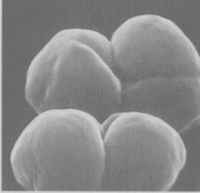Methanosarcina barkeri: Difference between revisions
| Line 52: | Line 52: | ||
==Current Research== | ==Current Research== | ||
[http://www.blackwell-synergy.com/doi/abs/10.1111/j.1365-2958.2006.05500.x Longstaff, DG and Blight, SK and Zhang, L and Green-Church, KB and Krzycki, JA. "In vivo contextual requirements for UAG translation as pyrrolysine". Molecular Microbiology. 2007. 63-1, p. 229-241.]<br /> | [http://www.blackwell-synergy.com/doi/abs/10.1111/j.1365-2958.2006.05500.x Longstaff, DG and Blight, SK and Zhang, L and Green-Church, KB and Krzycki, JA. "In vivo contextual requirements for UAG translation as pyrrolysine". Molecular Microbiology. 2007. 63-1, p. 229-241.]<br /><br /> | ||
"Pyrrolysine and selenocysteine have infiltrated natural genetic codes via the translation of canonical stop codons. UGA translation as selenocysteine is absolutely dependent on message context. Here we describe the first experimental examination of contextual requirements for UAG translation as pyrrolysine. A hexahistidine-tagged Methanosarcina barkeri mtmB1 gene, encoding monomethylamine methyltransferase MtmB1, was introduced into Methanosarcina acetivorans. Host mtmB expression was minimized by growth on methanol and recombinant mtmB1 products monitored by anti-MtmB and anti-hexahistidine immunoblotting. UAG translation was not compromised, as recombinant MtmB1 was 1% of cellular protein with only trace UAG-terminated mtmB1 product detectable. Untranslated regions flanking mtmB1 were not required for UAG translation, but loss of a downstream pyrrolysine insertion sequence (PYLIS) significantly increased the UAG-termination product of mtmB1 and decreased the UAG-translation product, which nonetheless contained pyrrolysine. An in-frame UAG within a bacterial uidA transcript was translated in the methanogen as pyrrolysine with 20% efficiency, suggesting UAG translation in the absence of evolved context. However, predominant UAG-directed termination with enhancement of UAG translation by the PYLIS appears analogous to cis-acting elements for UGA translation as selenocysteine, although different mechanisms may underlie these recoding events." | |||
==References== | ==References== | ||
Revision as of 17:09, 3 May 2007
A Microbial Biorealm page on the genus Methanosarcina barkeri
Classification
Higher order taxa
|
NCBI: Archaea; Euryarchaeota; Methanomicrobia; Methanosarcinales; Methanosarcinaceae; Methanosarcina |
Species
|
NCBI: Methanosarcina barkeri |
Strains
Methanosarcina barkeri str. MS
Methanosarcina barkeri str. W
Methanosarcina barkeri str. 227
Description and significance
Describe the appearance, habitat, etc. of the organism, and why it is important enough to have its genome sequenced. Describe how and where it was isolated. Include a picture or two (with sources) if you can find them.
Genome structure
Describe the size and content of the genome. How many chromosomes? Circular or linear? Other interesting features? What is known about its sequence? Does it have any plasmids? Are they important to the organism's lifestyle?
Cell structure and metabolism
Describe any interesting features and/or cell structures; how it gains energy; what important molecules it produces.
Ecology
Describe any interactions with other organisms (included eukaryotes), contributions to the environment, effect on environment, etc.
Pathology
Methanosarcina barkeri is an archaea and therefore causes no known diseases.
Application to Biotechnology
Does this organism produce any useful compounds or enzymes? What are they and how are they used?
Current Research
Longstaff, DG and Blight, SK and Zhang, L and Green-Church, KB and Krzycki, JA. "In vivo contextual requirements for UAG translation as pyrrolysine". Molecular Microbiology. 2007. 63-1, p. 229-241.
"Pyrrolysine and selenocysteine have infiltrated natural genetic codes via the translation of canonical stop codons. UGA translation as selenocysteine is absolutely dependent on message context. Here we describe the first experimental examination of contextual requirements for UAG translation as pyrrolysine. A hexahistidine-tagged Methanosarcina barkeri mtmB1 gene, encoding monomethylamine methyltransferase MtmB1, was introduced into Methanosarcina acetivorans. Host mtmB expression was minimized by growth on methanol and recombinant mtmB1 products monitored by anti-MtmB and anti-hexahistidine immunoblotting. UAG translation was not compromised, as recombinant MtmB1 was 1% of cellular protein with only trace UAG-terminated mtmB1 product detectable. Untranslated regions flanking mtmB1 were not required for UAG translation, but loss of a downstream pyrrolysine insertion sequence (PYLIS) significantly increased the UAG-termination product of mtmB1 and decreased the UAG-translation product, which nonetheless contained pyrrolysine. An in-frame UAG within a bacterial uidA transcript was translated in the methanogen as pyrrolysine with 20% efficiency, suggesting UAG translation in the absence of evolved context. However, predominant UAG-directed termination with enhancement of UAG translation by the PYLIS appears analogous to cis-acting elements for UGA translation as selenocysteine, although different mechanisms may underlie these recoding events."
References
Balch, WE, Fox, GE, Magrum, LJ, Woese, CR, and Wolfe, RS. "Methanogens: Reevaluation of a Unique Biological Group". Microbiological Reviews. June 1979. p. 260-296.
Maeder DL, Anderson I, Brettin TS, Bruce DC, Gilna P, Han CS, Lapidus A, Metcalf WW, Saunders E, Tapia R, Sowers KR. "The Methanosarcina barkeri Genome: Comparative Analysis with ...". Journal of Bacteriology. 2006. 188-22, p. 7922-7931.
Stadtman, TC and Barker, HA. "STUDIES ON THE METHANE FERMENTATION IX. The Origin of Methane in the Acetate and Methanol Fermentations by Methanosarcina". Journal of Bacteriology. 1951. 61-1, p. 81-86.
"Cutting cattle's methane emissions". USA Today (Magazine). June 01, 2002.
Atkins, JF and Gesteland, R. "The 22nd Amino Acid". Science. 2002. 296-5572, p. 1409-1410.
Edited by Ian Kerman, a student of Rachel Larsen at UCSD.

